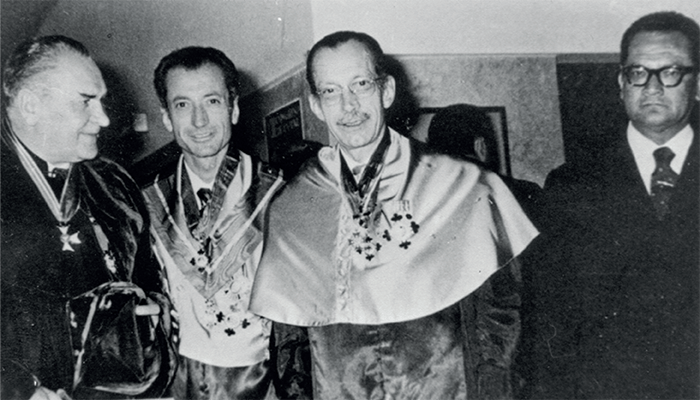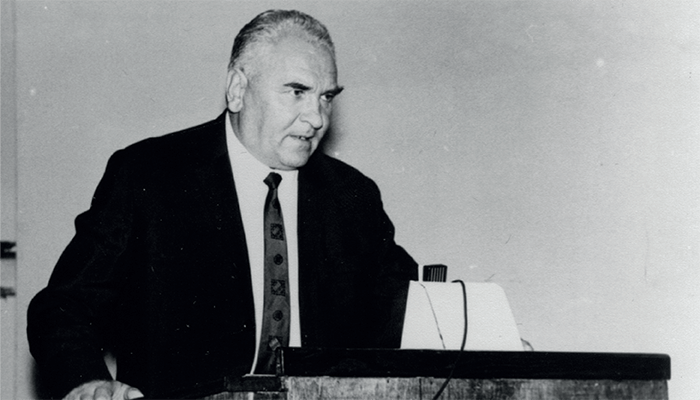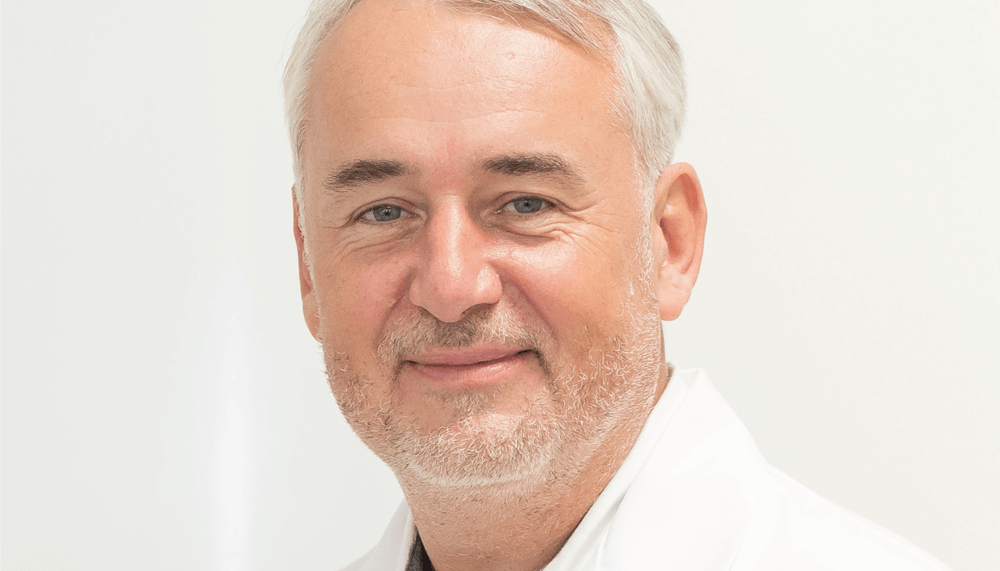 Tadeusz Krwawicz, 1910-1988.
Tadeusz Krwawicz, 1910-1988.
The idea of applying cryosurgery to ophthalmic care first came to Polish ophthalmologist Tadeusz Krwawicz in 1959 as he experimented with lyophilization to store corneas for transplantation. Through exploration, he observed that touching a wire cooled to –70°C to rabbit lenses resulted in firm attachment of the lens capsule and subcapsular material. This finding led him to develop a cryoextractor, which he found particularly helpful for intumescent cataracts and lens subluxation. His idea and primary results were published in the British Journal of Ophthalmology in 1961 (1). However, working in Soviet-controlled Poland, ruined by a communist economy and deprived of modern technology, he was lacking equipment. Noticeably absent was an operating microscope; instead, he improvised with Zeiss loupes able to magnify the image twice. In his own words: “When I described [the technique…], everyone asked me what kind of microscope I used. I did not have a microscope, and I was ashamed to admit it so I equivocated until everybody gave me a break,” (2).
As his cryoextractor was not protected by international patent rights, Krwawicz’s publication led to its uninhibited worldwide production. One famous pioneer of the technique in the US was Charles Kelman, inventor of phacoemulsification. Kelman developed his own cryoprobe a few years after Krwawicz, publicly acknowledging him as the technology’s originator. Another adopter was Selig Percy Amoils – a South African ophthalmologist and biomedical engineering inventor, who introduced a modern cryoprobe in 1965.
However, not everyone was so readily convinced. After seeing Krwawicz in Lublin, Poland, William Riddell, a well-renowned Scottish ophthalmologist, said, “I was there for a long time, I looked and saw a lot, I came to believe that he is either a madman or a genius. It is better we wait,” (3). The UK listened, delaying the introduction of cryosurgery by five years. Despite this, as cataract cryoextraction reduced complications, its use became routine in cataract removal for two decades, resulting in substantial progress in ophthalmology.
On the importance of Krwawicz’s discoveries, Fritz Hollwich, President of Academia Ophthalmologica Internationalis in 1980 stated, “The last hundred years witnessed a great progress in the treatment of glaucoma and the closure of the retinal detachment using the Gonin method. I am inclined to recognize Professor Krwawicz’s cryoextraction as the third achievement equally important as the two aforementioned,” (3). Sir Stewart Duke-Elder wrote in his System of Ophthalmology, “He will be always remembered for the introduction of cryosurgical techniques in 1959, especially cataract cryoextraction and cryotherapy of such diseases as viral infections of the cornea. These achievements made him well known all over the world.”
 Krwawicz during the ceremony of awarding the Barraquer y Barraquer Gold Medal.
Krwawicz during the ceremony of awarding the Barraquer y Barraquer Gold Medal.
Later, Zbigniew Zagórski, Professor of Ophthalmology and one of Krwawicz’s pupils, established the Tadeusz Krwawicz Chair of Ophthalmology in Lublin Medical University. Additionally, the International Council of Ophthalmology awards Tadeusz Krwawicz’s Gold Medal every four years during the World Ophthalmology Congress, recognizing significant contributions to ophthalmology, especially in anterior segment diseases, the introduction of new technologies, and the advancement of international relationships among ophthalmologists. Previous recipients are Douglas R. Anderson, USA (2008), Alan C. Bird, UK (2012), Marie-Jose Tassignon, Belgium (2016), and David F. Chang, USA (2020). Krwawicz was inducted into the American Society of Cataract and Refractive Surgery Hall of Fame in 2021.
Though Krwawicz may be difficult for some to pronounce, his name – and his achievements – need not be difficult to remember. Speaking during the 1972 ophthalmology congress, G. Peter Halberg, Director of Glaucoma Service at the New York Eye and Ear Infirmary, suggested Krwawicz change his name to “Cryo-Krwawicz,” (3), which, though clearly a joke, aptly links the man with his creation.
Andrzej Grzybowski is a Professor of Ophthalmology and Chair of Department of Ophthalmology, University of Warmia and Mazury, Olsztyn, Poland, and Head of Institute for Research in Ophthalmology, Foundation for Ophthalmology Development, Poznań, Poland.
He is also an expert in the history of ophthalmology, with over 100 peer-reviewed articles published in this area. He is a member of AAO Museum of Vision’s Program Committee, curator of ESCRS Archive, founder of history section at EVER. He is the president of the Polish Society for History and Philosophy of Medicine; Editor-in-Chief of Archives of History and Philosophy of Medicine, and Historia Ophthalmologica Internationalis, the only journal devoted solely to the history of ophthalmology.

References
- T Krwawicz, “Intracapsular extraction of intumescent cataract by application of low temperature,” Brit. J. Ophthal., 45, 279 (1961). PMID: 18170674.
- A Grzybowski, P Kanclerz, “Tadeusz Krwawicz, MD: The inventor of cryosurgery in ophthalmology,” Eur J Ophthalmol., 29, 348 (2019). PMID: 30638059.
- T Krwawicz, “Fragmenty autobiografii,” Kwart Hist Nauki Tech., 31, 275 (1986). PMID: 11629556.
